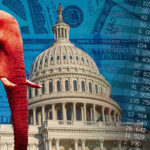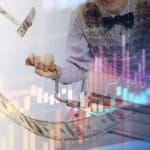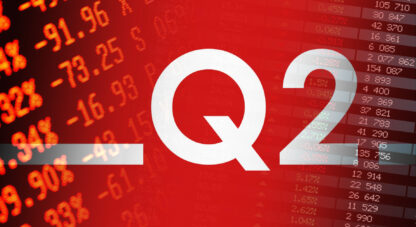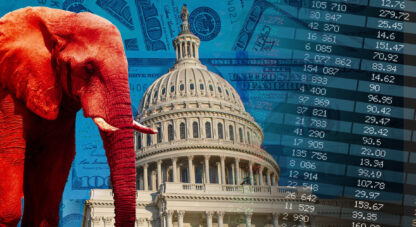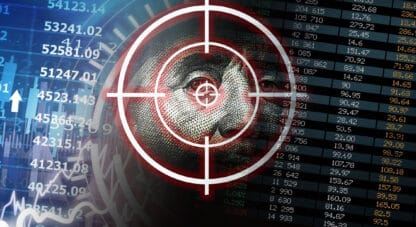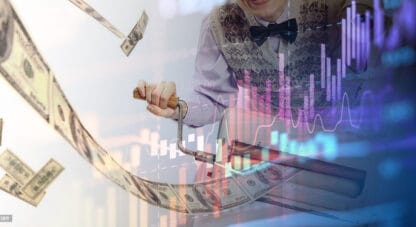The market week began with cases of the coronavirus jumping to 222, including four outside China. China’s National Health Commission confirmed human-to-human virus transmission. By Friday, more than 1,200 infections had been confirmed, with 41 deaths (8,420 under observation according to the Washington Post). China on Thursday suspended flights and travel out of Wuhan, a city of 11 million. The virus has quickly spread to Taiwan, Japan, South Korea, Thailand, Malaysia, Vietnam, Pakistan, Nepal, France, Australia and the United States.
China has moved to quarantine 13 cities involving an estimated 46 million, according to Bloomberg “the first large-scale quarantine in modern times.” From Bloomberg (Lisa Du): “‘The containment of a city hasn’t been done in the history of international public health policy,’ said Shigeru Omi, who headed the World Health Organization’s Western Pacific Region during the SARS outbreak in the early 2000s. ‘It’s a balance between respecting freedom of movement of people, and also prevention of further disease and public interest. It’s not a simple sort of thing; it’s very complex.’” Included in the 46 million are foreign nationals now unable to leave China.
A 1,000-bed emergency hospital is to be constructed in ten days in overwhelmed Wuhan, as 400 military doctors are deployed to support local providers. In Beijing and throughout the country, officials have cancelled “Year of the Rat” Chinese New Year’s celebrations. Beijing’s Forbidden City is closed to tourist until further notice. Across China, there is fear of going to markets, restaurants, movies and public events.
Nations around the globe have isolated ill patients awaiting coronavirus test results. That this scare is coming at the height of flu and cold season in the U.S. and other northern hemisphere countries adds further complication to a rapidly escalating crisis.
Florida Senator Rick Scott is urging the Trump administration to declare a public health emergency. Missouri Senator Josh Hawley has called for the administration to impose a temporary travel ban on flights from China. The coronavirus has the potential to turn highly disruptive to the Chinese economy, with wide-ranging effects on global markets and economies.
The Shanghai Composite dropped 2.8% in Thursday trading, and was down 3.2% for the week. Hong Kong’s Hang Seng index fell 3.8%, with the Hang Seng China Financials Index sinking 4.9%. For the most part, Asian equities ended the week with modest losses. Financial stocks were under pressure around the globe.
My Bubble thesis views China as the marginal source of both global Credit and demand for commodities (and much else). Any development posing risk to China’s vulnerable Bubble rather quickly becomes a pressing global issue. It’s worth noting the Bloomberg Commodities Index dropped 3.1% this week. WTI crude sank 7.4%, while Copper was hit for 5.7%. Nickel fell 6.9%, Tin 5.4% and Zinc 3.6%. China’s renminbi declined 1.2% versus the dollar. In spite of notable investor optimism and attendant financial flows, EM currencies reversed lower this week.
Global safe haven bonds appeared to believe the week’s developments were a big deal. Ten-year Treasury yields dropped 14 bps to a three-month low 1.685%, and German bund yields fell 12 bps to negative 0.34%. The two-year versus 10-year Treasury spread declined almost eight bps this week to a six-week low 18.5 bps (after ending 2019 at 34bps). The market now prices in a 41% probability of a rate cut by the July 29th FOMC meeting, up from the previous week’s 29%. While on the subject of safe havens, gold bucked this week’s commodities market selloff to gain 0.9% to $1,572.
U.S. stocks were under moderate pressure in early Thursday trading. By the close, the S&P500 was positive for the session and back near record highs. The situation turned more concerning by Friday. The S&P500 ended the session down 0.9%, with a loss for the week of 1.0%. The Bank index dropped almost 2% in Friday trading.
January 22 – Reuters: “U.S. home sales jumped to their highest level in nearly two years in December, the latest indication that lower mortgage rates are helping the housing market to regain its footing after hitting a soft patch in 2018. …Existing home sales increased 3.6% to a seasonally adjusted annual rate of 5.54 million units last month, the highest level since February 2018. November’s sales pace was unrevised at 5.35 million units… Existing home sales, which make up about 90% of U.S. home sales, surged 10.0% on a year-on-year basis in December. For all of 2019, sales were unchanged at 5.34 million units.”
Between the impeachment trial and the coronavirus, noteworthy housing data received scant attention. Housing and mortgage finance in 2020 will reemerge as prominent factors in U.S. Bubble Analysis, especially if global developments continue to pressure market yields (and mortgage rates) lower. While December Existing Home Sales (seasonally-adjusted) were the strongest in almost two years, more notable was the decline in available inventory to 3.0 months. This was down from November’s 3.7 months (and September’s 4.1) to the lowest level in the 20-year history of the data series. The chief economist for the National Association of Realtors stated, “America is facing a dire housing shortage condition.” Little wonder home price gains have begun to accelerate.
January 17 – Bloomberg (Prashant Gopal): “U.S. home prices rose the most in 19 months in December, fueled by low mortgage rates and the tightest supply on record, according to Redfin. Prices jumped 6.9% from a year earlier to a median of $312,500, the biggest annual increase since May 2018… Values fell in just two of the 85 largest metropolitan areas Redfin tracks: New York, with a 2.4% decline, and San Francisco, down 1.7%… Some of the most-affordable cities in Redfin’s study had the biggest price gains, led by Memphis, Tennessee, with a 16% jump. The inventory of available homes for sale nationwide tumbled 15% from a year earlier. There were fewer properties for sale last month than at any time since at least December 2012…”
January 21 – CNBC (Diana Olick): “Homebuilding took a sharp turn higher to end 2019, but it is far from enough to satisfy the current demand. The U.S. housing market is short nearly 4 million homes, according to new analysis from realtor.com. Analyzing U.S. census data, the report showed that the 5.9 million single-family homes built between 2012 and 2019 do not offset the 9.8 million new households formed during that time. Even with an above average pace of construction, it would take builders between four and five years to get back to a balanced market. The shortfall today can be blamed on the epic housing crash of more than a decade ago… With loans available to even the riskiest buyers, builders responded by putting up 1.7 million single-family homes at the peak of the construction boom in 2005, according to the U.S. census. That was about 5 million more than the 20-year average.”
January 23 – Wall Street Journal (James Mackintosh): “The Davos consensus can be a powerful counter-indicator, but this year it is worrying me for all the wrong reasons. Two years ago the elite assembled for the World Economic Forum in the Alps strongly believed in global growth, and were completely wrong. A year ago they were concerned, and again entirely wrong as markets subsequently soared. This year the problem is that I find myself sharing the consensus view, justifying high stock valuations on the basis of easy monetary policy. It is a deeply uncomfortable place to be.”
Bob Prince, Co-CIO of Bridgewater Associates (in a Bloomberg Television interview from Davos): “2018 I think was a lesson learned. The tightening of central banks all around the world wasn’t intended to cause a downturn – wasn’t intended to cause what it did. But I think lessons were learned from that. And I think it was really a marker that we’ve probably seen the end of the boom and bust cycle.”
Bloomberg’s Tom Keene: “Is it the end of the hedge fund business in modeling portfolios off the guestimates of what central banks will do?”
Prince: “That won’t play much of a role nearly as it has. You remember the eighties when we sat and waited for the money supply numbers. We’ve come a long way since then… Now we talk 25 plus [bps Fed rate increase] – 25 minus. We’re not even going to get 25 plus or minus and we have negative yields. That idea of the boom/bust cycle – and that history that we’ve been in for decades – is really driven by shifts in credit and monetary policy. But you’re in a situation now where the Fed is in a box. They can’t tighten, and they can’t ease – nor can other central banks, particularly the reserve currencies. And so where do you go from here? It’s not going to look like it has.”
Bloomberg’s Jonathan Ferro: “Bob, you just said it twice – and I’m still surprised. And you said it before the interview started… It’s the end of the boom/bust cycle?”
Prince: “As we know it.”
Ferro: “There was a man called Gordon Brown, former Chancellor of the United Kingdom, a famous scene in Parliament of him standing up and saying, “It’s the end of the boom/bust,” and it was right before the financial crisis. It’s the end of the boom/bust cycle? What does that mean?”
Prince: “Cycles in growth are caused by the boom and bust in Credit. Credit expansion, Credit contraction. And those expansions and contractions of Credit are largely driven by changes in monetary policy. And so we’re in a situation today where with interest-rates is close to zero and secular deflationary forces, you’re not going to get a tightening of monetary policy. They learned that lesson last year and got the unintended effects of that. You’re not going to get a tightening, and one of the reasons you’re not going to get a tightening is because they can’t ease. If you can’t ease you don’t want to tighten to cause a problem for yourself that you can’t get out of. Therefore, you’re in a box; you don’t tighten, and you don’t ease.”
Keene: “It sounds like you read (Ray) Dalio’s book.”
Prince: “We work together” (laughter).
Ferro: “…What are the investment implications…”
Prince: “The nature of the economic environment is changing. So, we are converging on something – a slow growth environment, I’d say close to stagnation – approaching stagnation. That’s why interest rates are at zero. That’s why real interest rates are negative – is because central banks have to make cash very unattractive…, but also they have to make bonds unattractive. Central banks have taken cash and bonds and they’ve made it a funding vehicle – not an investment vehicle. And they’re trying to keep that rate low so that money goes from bonds to assets.”
Noland: I’m always fascinated when highly intelligent market professionals say peculiar things. I’m still not over Ray Dalio’s concept of “beautiful deleveraging” from some years back. When I first heard Prince’s comments, I thought immediately of the eminent American economist Irving Fisher and his infamous, “Stock prices have reached what looks like a permanently high plateau” – just days ahead of the great 1929 stock market crash.
But there is an analytical framework behind Prince’s view worthy of discussion. I’m with him completely when it comes to, “Cycles in growth are caused by the boom and bust in Credit.” In a historical context, I can accept “those expansions and contractions of Credit are largely driven by changes in monetary policy.” I agree “you’re not going to get a tightening of monetary policy.” Prince says central banks are “in a box,” while I prefer “trapped.”
But it is as if Mr. Prince is suggesting there is now some type of equilibrium condition that precludes a boom and bust dynamic. I would counter that central banks are locked in a position of administering extreme monetary stimulus, fueling a runaway boom that will end in a historic bust. Markets clearly expect ongoing aggressive stimulus (QE) from all the major global central banks.
And I don’t buy into the popular “rates are near zero because of stagnation” argument. The Fed cut rates three times in 2019 due to market fragility and the risk of a faltering Bubble – that had little to do with U.S. economic performance. Global rates are where they are because of acute global Bubble-related fragilities and resulting extreme monetary stimulus. Low global market yields (and negative real yields) are more a Bubble Dynamic than a reflection of deflationary forces. A historic boom/bust dynamic has global bond markets anticipating enormous prospective central bank bond purchases (QE).
The critical question: Can runaway booms descend into busts without a tightening of monetary policy? The answer seems a rather obvious “absolutely”. I don’t believe the Fed’s timid tightening measures in 1999 and early 2000 precipitated the bursting of the Internet and technology Bubble. The Fed was cutting rates aggressively into 2002, yet that didn’t arrest the bust in corporate Credit. I would strongly argue the Fed’s even more cautious 2006/2007 rate increases were not the catalyst for the bursting of the mortgage finance Bubble. In reality, in the face of strengthening Bubble Dynamics, financial conditions loosened significantly as the Fed tiptoed along with its so-called “tightening” cycle.
The Fed emerged from the 1994 tightening cycle recognizing that contemporary finance – with its hedge funds, speculative leverage, derivatives and Wall Street securitized finance and proprietary trading– carried an elemental propensity for excess and instability. That was effectively the end of Federal Reserve policy tightening cycles. From then on, it was cautious little “baby steps” to ensure the Fed wouldn’t upset the markets.
The “tech” and mortgage finance booms were left to inflate free from central bank restraint. Uncommonly painful busts were inevitable. Today’s most protracted all-encompassing global boom has not only been left free to inflate, central bankers continue their multi-trillion spending spree to pressure nonstop inflation. I do agree: when this fiasco runs its course, it certainly won’t be boom and bust “as we know it.”
January 21 – CNBC (Yun Li): “Billionaire investor Paul Tudor Jones said the stock market today is reminiscent of the latter stages of the bull market in 1999 that saw a giant surge that ultimately ended with the popping of the dot-com bubble. ‘We are just again in this craziest monetary and fiscal mix in history. It’s so explosive. It defies imagination,’ Jones said… ‘It reminds me a lot of the early ’99. In early ’99 we had 1.6% PCE, 2.3% CPI. We have the exact same metrics today.’ ‘The difference is fed funds were 4.75%; today it’s 1.62%. And back then we had budget surplus and we’ve got a 5% budget deficit,’ Jones added. ‘Crazy times.’”
For the Week:
The S&P500 declined 1.0% (up 2.0% y-t-d), and the Dow fell 1.2% (up 1.6%). The Utilities jumped 2.5% (up 5.9%). The Banks sank 2.9% (down 5.0%), and the Broker/Dealers fell 2.5% (up 1.4%). The Transports slumped 1.9% (up 1.5%). The S&P 400 Midcaps fell 1.5% (up 0.1%), and the small cap Russell 2000 dropped 2.2% (down 0.4%). The Nasdaq100 slipped 0.4% (up 4.7%). The Semiconductors added 0.4% (up 4.0%). The Biotechs sank 4.3% (down 2.2%). With bullion jumping $14, the HUI gold index rallied 3.4% (down 2.2%).
Three-month Treasury bill rates ended the week at 1.495%. Two-year government yields declined six bps to 1.50% (down 7bps y-t-d). Five-year T-note yields dropped 12 bps to 1.51% (down 19bps). Ten-year Treasury yields sank 14 bps to 1.685% (down 23bps). Long bond yields fell 15 bps to 2.13% (down 26bps). Benchmark Fannie Mae MBS yields dropped 14 bps to 2.48% (down 23bps).
Greek 10-year yields fell 11 bps to 1.29% (down 14bps y-t-d). Ten-year Portuguese yields dropped 12 bps to 0.38% (down 6bps). Italian 10-year yields sank 14 bps to 1.23% (down 18bps). Spain’s 10-year yields fell 12 bps to 0.35% (down 12bps). German bund yields sank 12 bps to negative 0.34% (down 15bps). French yields fell 12 bps to negative 0.07% (down 19bps). The French to German 10-year bond spread was little changed at 27 bps. U.K. 10-year gilt yields declined seven bps to 0.56% (down 26bps). U.K.’s FTSE equities index fell 1.2% (up 0.6%).
Japan’s Nikkei Equities Index declined 0.9% (up 0.7% y-t-d). Japanese 10-year “JGB” yields declined two bps to negative 0.2% (down 1bp y-t-d). France’s CAC40 lost 1.3% (up 0.8%). The German DAX equities index added 0.4% (up 2.5%). Spain’s IBEX 35 equities index fell 1.2% (up 0.1%). Italy’s FTSE MIB index declined 0.7% (up 2.0%). EM equities were mostly lower. Brazil’s Bovespa index was little changed (up 2.4%), while Mexico’s Bolsa dropped 1.5% (up 3.7%). South Korea’s Kospi index slipped 0.2% (up 2.2%). India’s Sensex equities index declined 0.8% (up 0.9%). China’s Shanghai Exchange sank 3.2% (down 2.4%). Turkey’s Borsa Istanbul National 100 index added 0.5% (up 6.7%). Russia’s MICEX equities index fell 1.6% (up 3.3%).
Investment-grade bond funds saw inflows of $4.186 billion, and junk bond funds posted inflows of $719 million (from Lipper).
Freddie Mac 30-year fixed mortgage rates fell five bps to 3.60% (down 85bps y-o-y). Fifteen-year rates declined five bps to 3.04% (down 84bps). Five-year hybrid ARM rates sank 11 bps to 3.28% (down 62bps). Bankrate’s survey of jumbo mortgage borrowing costs had 30-year fixed rates down four bps to 3.95% (down 51bps).
Federal Reserve Credit last week declined $18.5bn to $4.114 TN, with a 19-week gain of $388 billion. Over the past year, Fed Credit expanded $103.5bn, or 2.6%. Fed Credit inflated $1.303 Trillion, or 46%, over the past 376 weeks. Elsewhere, Fed holdings for foreign owners of Treasury, Agency Debt declined $6.6 billion last week to $3.413 TN. “Custody holdings” increased $4.7 billion, or 0.1%, y-o-y.
M2 (narrow) “money” supply surged $46.3bn last week to a record $15.397 TN. “Narrow money” surged $969 TN, or 6.7%, over the past year. For the week, Currency increased $3.0bn. Total Checkable Deposits slipped $1.1bn, while Savings Deposits jumped $34.8bn. Small Time Deposits declined $1.7bn. Retail Money Funds rose $11.3bn.
Total money market fund assets added $3.5bn to $3.634 TN, with institutional money fund assets down $6.6bn to $2.255 TN. Total money funds gained $582bn y-o-y, or 19.1%.
Total Commercial Paper declined $6.3bn to $1.115 TN. CP was up $46.4bn, or 4.3% year-over-year.
Currency Watch:
January 22 – Financial Times (Tom Roderick): “Policymakers in Hong Kong have been riding their luck. They can be thankful for a dovish US Federal Reserve, which cut rates three times last year. That reduced the pressure on the Hong Kong dollar at a time of deepening political crisis in the Chinese territory. As the Hong Kong Monetary Authority runs out of options, the question is how long its currency can hold the line. For the past 37 years, the city has run a managed peg, tying the Hong Kong currency to the US dollar. Currently the greenback trades in a narrow band between HK$7.75-7.85. And given that the currencies are pegged, one should expect differences in market interest rates to be marginal.”
For the week, the U.S. dollar index added 0.3% to 97.853 (up 1.4% y-t-d). For the week on the upside, the Japanese yen increased 0.8%, the South African rand 0.5% and the British pound 0.4%. On the downside, the Norwegian krone declined 1.5%, the South Korean won 0.8%, the Australian dollar 0.7%, the Mexican peso 0.7%, the euro 0.6%, the Canadian dollar 0.6%, the Swedish krona 0.5%, the Brazilian real 0.5%, the Swiss franc 0.4%, the Singapore dollar 0.3%, and the New Zealand dollar 0.1%. The Chinese renminbi declined 1.19% versus the dollar this week (up 0.3% y-t-d).
Commodities Watch:
The Bloomberg Commodities Index sank 3.1% (down 4.4% y-t-d). Spot Gold rallied 0.9% to $1,572 (up 3.5%). Silver added 0.2% to $18.113 (up 1.1%). WTI crude sank $4.35 to $54.19 (down 11%). Gasoline dropped 7.6% (down 10%), and Natural Gas fell 5.8% (down 14%). Copper sank 5.7% (down 4%). Wheat increased 0.5% (up 3%). Corn declined 0.5% (unchanged).
Market Instability Watch:
January 24 – Reuters (Gertrude Chavez-Dreyfuss): “The New York Federal Reserve on Friday accepted all $55.3 billion in three-day bids from primary dealers at a repurchase agreement (repo) operation, aimed at maintaining the federal funds rate within the target range.”
January 24 – Reuters (Thyagaraju Adinarayan): “Global equity and bond funds saw more inflows in the week to Wednesday and the ‘irrational bullish phase’ in markets was likely to continue in the first-quarter if the U.S. Fed continued to pump-in liquidity, BofA said… Bond funds attracted $16.2 billion and equities sucked in $8.5 billion last week even as concerns over the spread of a deadly virus in China rattled markets, BofA said citing EPFR data. At $4 billion, emerging market equity funds saw their biggest inflows in 57 weeks.”
January 24 – Bloomberg (Brian Chappatta): “‘Worrisome.’ ‘Dangerous and aggressive.’ ‘Abuse of documentation.’ ‘Peak greed.’ These are just a few of the ways investors and analysts have described the riskiest corners of the debt markets in the past few days. From the U.S. to Europe, whether in collateralized loan obligations or junk bonds, the feeling that the reach for yield in fixed income is fast approaching a breaking point is becoming too powerful to ignore. It’s perhaps best encapsulated by a quote in the Wall Street Journal from Luca Cazzulani, a senior fixed-income strategist at UniCredit: ‘Investors are not really interested in safety, they are quite keen on yield.’
January 19 – Wall Street Journal (Paul J. Davies): “Global banks’ use of funding from markets rather than from customer deposits has grown rapidly in recent years, mostly in the form of short-term funding, which was a central problem of the 2008 financial crisis… However, that growing use has been spread unevenly around the globe. Banks in the U.S., U.K. and Canada have become among the biggest lenders into short-term financing markets, while banks in France and Japan are now the biggest borrowers after rapid growth in all these markets in 2017 and 2018. Short-term market funding is risky because it can suddenly disappear when lenders—typically money-market funds, fund managers or cash-rich banks—get concerned about the creditworthiness of borrowers, who can then be forced into a fire-sale of assets if the lenders pull back.”
January 21 – Associated Press (Elaine Kurtenbach): “News that a new virus that has afflicted hundreds of people in central China can spread between humans has rattled financial markets and raised concern it might wallop the economy just as it might be regaining momentum. Health authorities across Asia have been stepping up surveillance and other precautions to prevent a repeat of the disruptions and deaths during the 2003 SARS crisis, which caused $40 billion to $50 billion in losses from reduced travel and spending.”
January 22 – Bloomberg (Ken McCallum): “After years of falling debt yields and new technologies enabling one-click purchases of complex financial products, mom and pop investors around the world are making bets that put them at danger of getting burned. In South Korea, regulators are investigating sales of derivative-linked products that caused individuals to lose almost all their invested money. Chinese savers have ignored government warnings about possible losses on so-called wealth management products. In India, shadow banks whose woes have triggered a credit crisis have sold bonds to the public. The list goes on.”
January 23 – Bloomberg (Luke Kawa and Lananh Nguyen): “In 30 years at the premier U.S. options exchange, Ed Tilly has never seen an election sow more anxiety than the 2020 presidential race. The chief executive officer of Cboe Global Markets Inc. made the observation… Thursday. Tilly highlighted elevated demand for protection around important dates in the primary campaign and general vote showing up in the term structure of implied volatility.”
Trump Administration Watch:
January 21 – Reuters (Shubham Kalia): “The Phase 2 trade deal with China would not necessarily be a ‘big bang’ that removes all existing tariffs, U.S. Treasury Secretary Steven Mnuchin told the Wall Street Journal… ‘We may do 2A and some of the tariffs come off. We can do this sequentially along the way,’ he added. Mnuchin also warned that Italy and Britain will face U.S. tariffs if they proceed with a tax on digital companies like Alphabet Inc’s Google and Facebook…”
January 23 – CNBC (Jeff Cox): “The White House has started work on a second round of tax cuts even as the budget deficit continues to grow, Treasury Secretary Steven Mnuchin said… ‘The president has asked us to start working on what we call ‘tax 2.0,’ and that will be additional tax cuts,” Mnuchin told CNBC… ‘They’ll be tax cuts for the middle class, and we’ll also be looking at other incentives to stimulate economic growth.’ Talk of election-year tax cuts comes amid a swelling budget deficit that eclipsed $1 trillion for the 2019 calendar year. In addition, the total government debt recently passed $23 trillion, despite President Donald Trump’s promises that economic growth would wipe out the deficit and pull down the federal IOU.”
January 23 – Reuters (Susan Heavey and Doina Chiacu): “Treasury Secretary Steven Mnuchin said… the U.S. government cannot sustain federal deficits growing at current levels and will have to slow the rate of spending. As he acknowledged the administration of Republican President Donald Trump was considering additional tax cuts to stimulate the economy, Mnuchin blamed government spending – and Democrats in Congress – for the federal deficit.”
January 22 – CNBC (Mike Calia): “President Donald Trump told CNBC… that U.S. economic growth would have been closer to 4% if it weren’t for the lingering effect of Federal Reserve rate hikes… The president also suggested that the stock market would be even higher than its already record-setting highs if the Fed hadn’t raised rates so quickly before cutting them three times during 2019. ‘Now, with all of that, had we not done the big raise on interest, I think we would have been close to 4%,’ Trump said of the U.S. gross domestic product. ‘And I – I could see 5,000 to 10,000 points more on the Dow. But that was a killer when they raised the rate. It was just a big mistake.’”
January 22 – Bloomberg (Alfred Cang, Javier Blas, and Isis Almeida): “Donald Trump’s trade truce with Beijing included a pledge to buy billions of dollars of U.S. foodstuffs over the next two years, reopening one of the most important export markets for America’s farm belt. ‘The farmers are really happy with the new China Trade Deal,’ the president tweeted the day after a signing ceremony in the White House. The euphoria is fading fast. The dispute with Washington exposed Beijing’s vulnerability when it comes to food imports — especially the soybeans needed to feed its massive herd of livestock — and the Communist Party leadership will now do all it can to wean itself off the U.S. ‘Anytime you have a disruption in your supply chain, and especially with something as sensitive as food, they have to diversify their supply chain,’ said David MacLennan, chief executive of Cargill…”
January 22 – Reuters (Aziz El Yaakoubi and Ahmed Rasheed): “Iranian-backed Shi’ite factions have exhorted Iraqis to turn out for a ‘million-strong’ march on Friday aimed at whipping up anti-American sentiment as the United States’ struggle with Iran plays out on the streets of Baghdad. Those behind the rally have two goals in mind – to pressure Washington to pull its troops out of Iraq, and to eclipse the mass anti-government protests that have challenged their grip on power.”
January 21 – Reuters (Stephanie Nebehay): “North Korea said… it was no longer bound by commitments to halt nuclear and missile testing, blaming the United States’ failure to meet a year-end deadline for nuclear talks and ‘brutal and inhumane’ U.S. sanctions. North Korean leader Kim Jong Un set an end-December deadline for denuclearization talks with the United States and White House national security adviser Robert O’Brien said at the time the United States had opened channels of communication.”
Federal Reserve Watch:
January 17 – Bloomberg (Jesse Hamilton): “The Federal Reserve is shifting its focus from writing and revising rules aimed at limiting risk in the banking system to a concentration on how lenders interpret the restrictions, the agency’s supervision chief said… ‘Supervisors promote good risk management and thus help banks preemptively avert excessive risk-taking that would be costly and inefficient to correct after the fact,’ Quarles said. ‘Where banks fall materially out of compliance with a regulatory framework or act in a manner that poses a threat to their safety and soundness, supervisors can act rapidly to address the failures.’”
U.S. Bubble Watch:
January 24 – Dow Jones (Orla McCaffrey): “The mortgage market in 2019 had its best year since the height of the precrisis boom, the latest sign that housing is firming up after showing signs of weakness early last year. Lenders extended $2.4 trillion in home loans last year, the most since 2006, according to… Inside Mortgage Finance. That was also a 46% increase from 2018.”
January 21 – Wall Street Journal (Jean Eaglesham): “A brewing battle over how to treat more than $5.5 trillion in assets on company books is pitting investors against businesses, investment advisers against academics and even banks against their own trade association. At issue is an accounting term known as goodwill, which is the premium a company pays when it buys another for more than the value of its net assets. An unprecedented five-year boom in mergers and acquisitions has added urgency over how to account for the financial concept. When Amazon.com Inc. bought Whole Foods Market Inc. for $13.7 billion in 2017, the e-commerce giant paid $9 billion more than the value of the supermarket’s stores and other net assets. That amount was added to Amazon’s books as goodwill.”
Fixed-Income Bubble Watch:
January 21 – Financial Times (Joe Rennison, Robert Armstrong and Robin Wigglesworth): “When Josh Barrickman became known as the new ‘bond king’, his colleagues teased the taciturn fund manager by leaving paper crowns from Burger King at his desk. The low-key Ohio native may not have the high profile of bond market stars such as Bill Gross but he has earned his title. The fund he runs, the Vanguard Total Bond Market, is the world’s biggest fixed income fund, with $247bn in assets under management. The fund’s table-topping position exemplifies the revolution under way in the $9tn US bond market. Unlike the freewheeling, actively-managed Total Return fund once run by Mr Gross, Vanguard’s flagship bond fund is a passive, index-tracking fund. It takes a smaller fee from investors and tries to track the market, not beat it.”
January 24 – Bloomberg (Lisa Lee and Olivia Raimonde): “Investors, eager to snatch up higher-
yielding corporate debt, are buying even the leveraged loans they shied away from for most of 2019. Some of the riskiest companies are now jumping at the opportunity to borrow. Private equity firms are piling bigger loads of debt onto buyout targets. Junk-rated corporations, including one that exited bankruptcy not long ago, are managing to cut interest rates on loans at the fastest pace since November 2017 by one measure… Money managers are looking to buy new loans now that the chances of recession seem to be falling and the Federal Reserve is evidently on hold.”
January 20 – Wall Street Journal (Anna Hirtenstein and Pat Minczeski): “U.S. blue-chip companies raised an unprecedented sum in eurozone debt markets last year, reflecting the region’s ultralow interest rates and global investors’ thirst for securities issued by highly rated companies. Coca-Cola Co. and International Business Machines Corp. were among the companies that raised a total of €101.7 billion ($113.5bn)—a record… by selling corporate bonds denominated in euros in the past year, according to… Dealogic. That was more than double the €42.2 billion raised the previous year…”
January 23 – Bloomberg (Laura Benitez): “One of the riskiest corners of the European bond market is enjoying its busiest January ever as companies rush to grab ultra-cheap yields and some of the more dubious instruments popular ahead of the financial crisis resurface. Junk-rated borrowers lined up close to 7 billion euros of issuance into the market this week, with sales nearing the 10 billion euro mark ($11bn) this month… ‘We’re definitely in peak greed territory,’ Olivier Monnoyeur, a portfolio manager at BNP Paribas Asset Management… ‘We’ve seen this movie before, and it doesn’t end well.’”
China Watch:
January 24 – Reuters (Judy Hua and Cate Cadell): “China shut part of the Great Wall and suspended public transport in 10 cities, stranding millions of people at the start of the Lunar New Year holiday… as authorities rush to contain a virus that has killed 26 people and infected more than 800. The World Health Organization (WHO) has declared the new coronavirus an “emergency in China” but stopped short of declaring it of international concern.”
January 23 – Bloomberg: “China is struggling to contain rising public anger over its response to a spreading coronavirus even as it took unprecedented steps to slow the outbreak, restricting travel for 40 million people on the eve of Lunar New Year.”
January 22 – Bloomberg (Jeanny Yu): “From a gas supplier to a shopping mall operator, stocks with ties to the Chinese city at the heart of a virus outbreak are falling. Wuhan Department Store Group Co., which operates several malls in Wuhan, lost 3.1% to head for a weekly drop of 16%. Hubei Heyuan Gas Co., which generates all of its revenue from Hubei province, extended its two-day drop to 10%, the biggest on record.”
January 20 – Bloomberg: “Most of China’s provinces are expecting slower economic growth in 2020, underlining the nationwide trend which is expected to result in a tweaking of the formal goal when the legislature meets in March. Twenty-two of 31 major cities, provinces and autonomous regions have so far cut their 2020 target for gross domestic product expansion… Twelve provinces, which made up 42% of China’s economic output at the end of September last year, expect growth at around 6% or lower this year. Another nine provinces forecast their economy would expand between 6%-6.5% this year.”
January 21 – Wall Street Journal (Chao Deng): “For years, China’s small banks had a field day. They lent to overstretched borrowers, disguised loans as investment products and fueled their business with short-term funds. One chairman dined out on delicacies like sea cucumber while ramping up lending to politically connected borrowers. Some banks funneled money to their own shareholders, others hid debt with financial engineering and haven’t reported complete information for years. Regulators used a light touch, eager to keep credit flowing to areas ignored by big national lenders. The country’s years of rapid economic growth papered over shoddy practices. Now, the bill is coming due. China’s growth rate is down by more than half from its peak a decade ago, nonperforming loans have expanded and the government is reining in banking risk. China is confronting a bank cleanup that could require hundreds of billions of dollars in bailouts.”
January 19 – Reuters (Shen Yan and Brenda Goh): “China expects the country’s vehicle sales to remain at around 25 million units in 2020, and could be flat or decline, Industry Minister Miao Wei said…”
January 22 – Bloomberg: “Investors will be closely watching HNA Group Co. as $500 million of dollar bonds mature this week, testing the debt-laden Chinese conglomerate’s repayment ability. A $200 million bond issued by HNA Group International will come due Jan. 23, while its $300 million note is set to mature a day later…”
January 20 – Reuters (Akshay Balan and Donny Kwok): “Moody’s downgraded Hong Kong’s credit rating one notch to ‘Aa3’ from ‘Aa2’ …, saying its view on the strength in the Chinese-ruled city’s institutions and governance is ‘lower than previously estimated.’ …‘The absence of tangible plans to address either the political or economic and social concerns of the Hong Kong population that have come to the fore in the past nine months may reflect weaker inherent institutional capacity than Moody’s had previously assessed,’ the agency said…”
Central Bank Watch:
January 22 – Financial Times (Martin Arnold and Mehreen Khan): “Every good central banker needs a legacy. Mario Draghi, the former head of the European Central Bank, is widely credited with rescuing the eurozone from a debt crisis. Today his successor, Christine Lagarde, will kick off the search for a defining cause of her own. Ms Lagarde will launch the second strategic review in the 20-year history of the ECB — a process that she has said will last until December as it turns ‘every stone’ in search of ways to fine tune its monetary policy toolkit.”
January 23 – Financial Times (David Crow): “Eurozone bank executives have launched a fresh lobbying push to convince policymakers of the dangers of long-term negative interest rates, warning they will hurt savers and pensioners while fuelling price bubbles in riskier assets. Bank chief executives have spent the past two years trying to force the European Central Bank to reverse its negative interest rates, which were first introduced in 2014. Other European central banks including Switzerland and Denmark also have negative rates. Rates below zero have slashed the amount that the region’s lenders earn from bread-and-butter lending and crushed their profit margins.”
January 20 – Reuters (Leika Kihara and Takahiko Wada): “The Bank of Japan nudged up its economic growth forecasts… and was cautiously optimistic about the global outlook, though it said ongoing risks meant it was far too soon to consider scaling down its massive stimulus program. The central bank signaled an expected domestic boost from a government fiscal spending package and Governor Haruhiko Kuroda, citing the U.S.-China Phase 1 trade deal, said overseas risks have subsided somewhat.”
January 20 – Reuters (Marc Jones and John Revill): “Central banks can’t be expected to save the world from climate change, a new book by the Bank for International Settlement said…, urging instead global co-ordination ranging from government policy to financial regulation. The book, titled ‘the Green Swan’, in a play on the idea of ‘black swan’ events, warned of the potentially seismic effects of climate change on the world’s financial system.”
EM Watch:
January 21 – Wall Street Journal (Santiago Pérez and Ryan Dube): “A far-left governor of Argentina’s most populous province is rattling investors with plans to hold off paying back foreign debt, raising fears that his faction of the ruling Peronist coalition could push the rest of the federal government into a messy new debt default. Axel Kicillof, Argentina’s former finance minister and new governor of Buenos Aires province, has given creditors until Wednesday night to accept a three-month delay in the repayment of $250 million in foreign debt issued by the Buenos Aires province due this coming Sunday. Prices of those bonds plunged after his announcement last week… The move comes as Argentina’s federal government prepares for negotiations with creditors to try to restructure more than $100 billion in debt that the government says it can’t repay.”
January 19 – Financial Times (Colby Smith and Robin Wigglesworth): “The developing world’s rapidly swelling corporate debt market is an accident waiting to happen, according to a prominent emerging-markets hedge fund that says a lack of liquidity could lead to violent price declines in a crisis. In a letter to investors…, Gramercy Funds Management wrote that the risk of sudden dislocations has been increased by a wave of bond buying by mutual funds and exchange traded funds that allow investors to pull out money quickly. ‘We are convinced that ‘liquid markets’ are not necessarily liquid,’ Robert Koenigsberger, chief investment officer, wrote… ‘The ‘perfect dislocation storm’ [is] waiting to happen.’”
January 19 – Bloomberg (Paul Wallace): “The yield on Lebanon’s next Eurobond to mature rocketed to more than 200% last week as the government’s prospects of avoiding a default diminished. Fitch… warned it may downgrade the country if it pushed ahead with a plan to get local holders of $1.2 billion of debt due on March 9 to swap into longer-dated bonds, instead of repaying it. The Arab nation has been wracked by protests since October over corruption and worsening living standards.”
January 22 – Reuters (Karin Strohecker, Tom Arnold and Tom Perry): “Lebanon’s new government faces huge upcoming debt repayments and a currency peg at breaking point, but it may already have run out of the hard cash firepower it needs to tackle these problems. The heavily indebted country faces hefty bond repayments coming up in March and April, when $1.34 billion and $842 million of interest and principal respectively come due. Analysts expect the central bank to be able to foot the bill, for now, though some in Beirut believe a rescheduling or restructuring is preferable.”
India Watch:
January 21 – Associated Press (Sheikh Saaliq): “A decision by the International Monetary Fund to downgrade its economic growth forecast for India is adding to pressure on Indian Prime Minister Narendra Modi over his policies. Opposition leaders and economists… blasted the government for failing to deliver on promises to reform the economy and keep growth on track. On Monday, the IMF slashed its growth estimate for the current fiscal year to 4.8% from 6.1% in the last fiscal year. It said India’s slowing growth was the single biggest drag on its global growth forecast in the past two years.”
January 21 – Bloomberg (Subhadip Sircar): “Global funds have turned net sellers of India’s sovereign bonds for the first time in four months, as expectations grow of a wider budget deficit. Foreign investors sold 110.2 billion rupees ($1.5bn) of government bonds so far in January, set for its first sell-off in four months, according to… Clearing Corp. of India… An increasing number of analysts predict that Prime Minister Narendra Modi will again announce a record borrowing plan at the Feb. 1 budget.”
January 23 – Bloomberg (Kartik Goyal): “A bond fund manager who correctly predicted that India’s central bank would introduce a U.S. Federal Reserve style Operation Twist, now says that the nation needs more foreign capital to fund its record borrowing. India’s borrowing may rise to 7.6 trillion rupees ($107bn) for the fiscal year starting April. 1, according to Suyash Choudhary, head of fixed income at IDFC Asset Management Co.”
January 22 – Bloomberg (Jeanette Rodrigues and Haslinda Amin): “The head of India’s biggest lender said he’s certain ‘some solutions will emerge’ to steady Yes Bank Ltd., which has been on a prolonged quest to raise new capital. ‘Yes Bank is a significant player in the market with an almost $40 billion balance sheet,’ State Bank of India Chairman Rajnish Kumar told Bloomberg… ‘I have a feeling that it will not be allowed to fail,’ he added. Kumar’s statement follows speculation that the government, which controls State Bank of India, may ask the lender to play a role in bailiing out the private-sector Yes Bank.”
Europe Watch:
January 21 – Reuters (Angelo Amante and Gavin Jones): “Luigi Di Maio stepped down… as leader of Italy’s co-governing 5-Star movement, as it seeks to stem a wave of defections that threatens the government’s parliamentary majority. While his decision is not expected to bring down the government, it underscores deep divisions within 5-Star and injects further uncertainty into already fractious relations with its coalition partner, the center-left Democratic Party (PD).”
January 22 – Bloomberg (William Shaw and James Hirai): “The prospect of a comeback for the populist Italian firebrand Matteo Salvini was hanging over markets… after a key political rival stepped down, raising the chances of an early election that could pave the way for him to pursue his euroskeptic agenda. The resignation of Luigi Di Maio as leader of the Five Star Movement has unsettled investors wary of another standoff between Italy and the European Union. Bonds fell as much as eight basis points on fears about the government’s stability but then recovered as the fragile coalition held together.”
Japan Watch:
January 22 – Reuters (Tetsushi Kajimoto): “Japan’s exports fell for a 13th straight month in December, hurt by U.S.-bound shipments of cars, construction and mining machinery, suggesting weak external demand is likely to remain a drag on the trade-reliant economy for a while longer. The 6.3% year-on-year fall in exports was worse than a 4.2% decrease expected… It followed a revised 7.9% year-on-year decline in the previous month…”
Global Bubble Watch:
January 19 – Reuters (George Obulutsa): “The world’s richest 2,153 people controlled more money than the poorest 4.6 billion combined in 2019, while unpaid or underpaid work by women and girls adds three times more to the global economy each year than the technology industry, Oxfam said…”
January 20 – Wall Street Journal (Stu Woo and Asa Fitch): “In terms of technology, the world had been unifying for years. Now it is reverting back to the likes of the VHS-versus-Betamax era, with much bigger consequences. Imagine two countries with completely different sets of hardware and software for the internet, electronic devices, telecommunications, and even social media and dating apps. That is the direction the U.S. and China are headed in—a world where the two global powers have mutually exclusive technology systems. The wedge being driven between the two countries alarms tech’s biggest names…”
January 17 – Financial Times (Jennifer Ablan): “Everything worked in 2019. US stocks, junk bonds, silver, oil, bitcoin and even Greece-focused exchange traded funds posted stunning gains, boosted by easy central bank policies. Now new risks lurk, as the US Federal Reserve continues to keep interest rates low and pursue monthly liquidity injections, as well as purchases of Treasury bills at a similar magnitude as previous rounds of quantitative easing. Such efforts have helped to send nearly every asset class into ‘bubbly’ territory. But a growing band of voices on Wall Street is warning of a possible consequence of this ever-looser monetary policy: inflation, which could dominate headlines this year for the first time in many. Jeffrey Gundlach, chief executive of DoubleLine Capital, said it was a remarkable day for financial markets in late October, when Fed chair Jay Powell said he would need to see a ‘really significant move up in inflation that’s persistent, before we would even consider raising rates to address inflation concerns’.”
January 19 – Bloomberg (Jacqueline Poh and Ruth McGavin): “The whole financial world is working to move away from Libor and other interbank lending benchmarks, which for decades have been used to set borrowing costs on bonds and loans, as well as products ranging from derivatives to credit cards. Since 2018, more than $150 billion worth of bonds have been sold using rates set by a new generation of benchmarks. The syndicated loan market is lagging far behind, with at least $12 trillion of deals needing to be replaced or rewritten so they follow a Libor alternative. There are no easy fixes in sight despite potential deadlines as early as this year.”
January 23 – Reuters (Matthew Green): “Australia’s bushfires are contributing to one of the biggest annual increases in the concentration of carbon dioxide in the Earth’s atmosphere since record-keeping began more than 60 years ago, according to a forecast… by Britain’s Met Office…”
Leveraged Speculation Watch:
January 22 – CNBC (Fred Imbert): “Billionaire hedge fund manager Seth Klarman is warning this rally that has taken stocks to record highs could soon end. Klarman, who runs Baupost Group in Boston, wrote in a letter to investors that the ‘the rocket fuel that has propelled markets in 2019 will run out,’ according to a Bloomberg News report.”
January 22 – Bloomberg (Melissa Karsh): “Hedge funds suffered almost $98 billion in net outflows in 2019, the most in three years, as managers trailed the stock market rally. Investors pulled more than $16 billion from the industry in December alone, capping a year that saw the longest stretch of monthly client withdrawals since the 2008 financial crisis, according to… eVestment. The redemptions equal about 3% of industry assets and are almost triple the $37.2 billion in outflows seen in 2018. Hedge funds are under pressure as investors revolt after years of high fees and lackluster performance.”
January 19 – Bloomberg (Nishant Kumar): “Billionaire money managers Chris Hohn and Stephen Mandel led hedge fund gains last year as surging markets helped the $3 trillion market post its best performance in a decade. The industry racked up gains worth $178 billion after fees, according to… LCH Investments, a fund of hedge funds. Hohn’s TCI Fund Management made $8.4 billion for clients, while Mandel’s Lone Pine Capital enriched investors by $7.3 billion.”
Geopolitical Watch:
January 21 – Financial Times (Kathrin Hille): “Taiwan’s identity as an independent democracy crystallised with the landslide re-election of President Tsai Ing-wen on a platform to defend the country’s institutions against China. Ms Tsai’s victory has even sparked a heated debate within the defeated Kuomintang (KMT), the opposition party which once ruled China, over how it can recast its policy towards the mighty neighbour to become palatable to voters again. Ms Tsai has called on Beijing to face reality over Taiwan. But for the Chinese Communist party (CCP) some things cannot be allowed to change, including the goal that Taiwan… must come under its control.”
January 21 – Financial Times (James Politi): “Last month, Robert Zoellick, former president of the World Bank and US trade representative, addressed a group of top US executives with business in China with a warning and a challenge. …With Cui Tiankai, China’s ambassador to the US, in the audience, Mr Zoellick asked if the gathering was ‘ready’ for a slide into US-China conflict. ‘The 20th century painted a shocking picture of industrial-age destruction; do not assume that the cyber era of the 21st century is immune to crack-ups or catastrophes of equal or even greater scale,’ Mr Zoellick said. ‘You need to decide whether you think the United States can still co-operate with China to mutual benefit while managing differences, and if so, how.’ His words captured the fears — particularly within parts of Washington’s economic and foreign policy establishment — that US President Donald Trump’s trade war against Beijing has paved the way for an irreversible ‘decoupling’ of the world’s two largest economies.”
January 19 – Wall Street Journal (Kathryn Dill and Kurt Wilberding): “Worries about income inequality, jobs disappearing due to automation and environmental sustainability are all feeding wide-scale distrust in capitalism as the world knows it, according to a new study… Edelman, a public-relations firm, conducted its 20th annual analysis of public trust in major institutions, surveying 34,000 people in 27 countries and Hong Kong. The data reveal both skepticism about those institutions—including government, business, the media and nongovernmental organizations—and a hunger for leadership on important issues. Anxiety about future employment prospects, wage gaps between the rich and middle class and corruption have made many people question the very systems of capitalism and democracy, the study found.”
January 19 – Bloomberg (Dave Graham): “Mexico should move to deepen its economic ties with China after U.S. congressional approval of a new North American trade deal, a senior Mexican official said… Jesus Seade, the deputy foreign minister for North America and Mexico’s top trade negotiator, said that as the second year of President Andres Manuel Lopez Obrador’s six-year term got underway, boosting economic ties with China was vital.”



